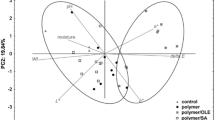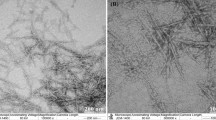Abstract
Rancidity due to the lipid oxidation process is a critical factor influencing the quality of roasted peanuts. Sonication in combination with edible coatings added with plant extracts may extend the oxidative stability of peanuts. Peanuts were roasted at 178°C for 15 min, subjected to sonication in hexane for 10 min, and then coated with carboxymethyl cellulose (CMC) solution mixed with rosemary, tea extracts, and α-tocopherol and stored at 35°C for 12 weeks. The oxidative stability of the samples was investigated by measuring the oxidative stability index. Reduction in oxidation of 66.1% and 10.4% was observed for samples roasted and coated with extracts of rosemary and tea, respectively, as compared to uncoated sample. However, the oxidative stability of samples roasted–sonicated and coated with extracts of rosemary and tea was improved by 100.7% and 28.1%, respectively, in relation to the control. Sonication beyond coating improved the oxidative stability of the samples mixed with rosemary, tea extracts, and α-tocopherol by 10.3%, 12.1%, 34.6%, and 17.7%, respectively. The L *, a *, and b * values indicated that the peanut coated with CMC mixed with rosemary, tea extracts, and tocopherol at different concentration levels did not have significant (P < 0.05) color change during the 12-week storage at 35°C.





Similar content being viewed by others
References
Albu, S., Joyce, E., Paniwnyk, L., Lorimer, J. P., & Mason, T. J. (2004). Potential for the use of ultrasound in the extraction of antioxidants from Rosmarinus officinalis for the food and pharmaceutical industry. Ultrasonics Sonochemistry, 11(3–4), 261–265. doi:10.1016/j.ultsonch.2004.01.015.
Association of Official Analytical Chemists (AOAC) (1995). Official methods of analysis (16th ed.). Arlington: AOAC.
Baldwin, E. A., Nisperos, M. O., Chen, X., & Hagenmaier, R. D. (1996). Improving storage life of cut apple and potato with edible coating. Postharvest Biology and Technology, 9, 151–163. doi:10.1016/S0925-5214(96)00044-0.
Ball, J. A. (1999). Development and effectiveness of three hydrocolloid-lipid emulsion coatings on preservation of quality characteristics in green bell peppers. Ph.D. Thesis, Virginia Polytechnic Institute and State University, USA.
Bravo, L., Goya, L., & Lecumberri, E. (2007). LC/MS characterization of phenolic constituents of mate (Ilex paraguariensis, St. Hil.) and its antioxidant activity compared to commonly consumed beverages. Food Research International, 21(40), 393–405. doi:10.1016/j.foodres.2006.10.016.
Chemat, F., Grondin, I., Costes, P., Moutoussamy, L., Shum, C., Sing, A., & Smadja, J. (2004). High power ultrasound effects on lipid oxidation of refined sunflower oil. Ultrasonics Sonochemistry, 11(5), 281–285. doi:10.1016/j.ultsonch.2003.07.004.
Chen, Z. Y., & Chan, P. T. (1996). Antioxidative activity of green tea catechins in canola oil. Chemistry and Physics of Lipids, 82, 163–172.
Chu, Y. H., & Hsu, H. S. (1999). Effects of antioxidants on peanut oil stability. Journal of Food Chemistry, 66, 29–34. doi:10.1016/S0308-8146(98)00082-X.
Coulter, R. B. (1988). Extending shelf-life by using traditional phenolic antioxidants. Cereal Foods World 33. In Y.-H. Chu, & H.-S. Hsu (Eds.), 1999. Effects of antioxidants on peanut oil stability (pp. 207–210). Journal of Food Chemistry, 66, 29–34.
Draco Natural Products (2007). http://www.dracoherbs.com/articles.htm. Accessed Nov 2007.
Estévez, M., & Cava, R. (2006). Effectiveness of rosemary essential oil as an inhibitor of lipid and protein oxidation: Contradictory effects in different types of frankfurters. Meat Science, 72, 348–355. doi:10.1016/j.meatsci.2005.08.005.
Farhoosh, R., Gholam, A., Golmovahhed, G. A., Mohammad, H. H., & Khodaparast, M. H. H. (2007). Antioxidant activity of various extracts of old tea leaves and black tea wastes (Camellia sinensis L.). Food Chemistry, 100, 231–236. doi:10.1016/j.foodchem.2005.09.046.
Frankel, E. N. (1993). In search of better methods to evaluate natural antioxidants and oxidative stability in food lipids. Trends in Food Science & Technology, 11, 220–225. doi:10.1016/0924-2244(93)90155-4.
Frutos, M. J., & Hernández-Herrero, J. A. (2005). Effects of rosemary extract (Rosmarinus officinalis) on the stability of bread with an oil, garlic and parsley dressing. Lebensmittel-Wissenschaft und-Technologie, 38, 651–655.
Huang, D., Ou, B., Hampsch-Woodill, M., Flanagan, J. A., & Deemer, E. K. (2002). Development and validation of oxygen radical absorbance capacity assay for lipophilic antioxidants using randomly methylated â-cyclodextrin as the solubility enhancer. Journal of Agricultural and Food Chemistry, 50(7), 1815–1821.
Huang, S., Frankel, E. N., & German, J. B. (1995). Effects of individual tocopherols and tocopherol mixtures on the oxidative stability of corn oil triglycerides. Journal of Agricultural and Food Chemistry, 43, 2345–2350. doi:10.1021/jf00057a006.
Lampi, A. M., Piironen, V., Hopia, A., & Koivistoinen, P. (1997). Characterization of oxidation of rapeseed and butter oil triacylglycerols by four analytical methods. Lebensmittel-Wissenschaft Technologie, 30, 807–813. doi:10.1006/fstl.1997.0273.
Lee, S. Y., Trezza, T. A., Guinard, J. X., & Krochta, J. M. (2002). Whey-protein-coated peanuts assessed by sensory evaluation and static headspace gas chromatography. Journal of Food Science, 67(3), 1212–1217. doi:10.1111/j.1365-2621.2002.tb09479.x.
Lin, S. Y., & Krochta, J. M. (2005). Whey protein coating efficiency on surfactant modified hydrophobic surfaces. Journal of Agricultural and Food Chemistry, 53, 5018–5023. doi:10.1021/jf0481305.
Malcolmson, L. J., Vaisey-Jenser, M., Przybylski, R., & Eskin, N. A. M. (1994). Sensory stability of canola oil: present status of shelf life studies. Journal of the American Oil Chemists’ Society, 71, 435–440. doi:10.1007/BF02540526.
Manzocco, L., Anese, M., & Nicoli, M. C. (1998). Antioxidant properties of tea extracts as affected by processing. Lebensmittel-Wissenschaft Technologie, 31, 694–698. doi:10.1006/fstl.1998.0491.
Mason, T. J., Paniwnyk, L., & Lorimer, J. P. (1996). The uses of ultrasound in food term technology. Ultrasonics Sonochemistry, 3, S253–S260. doi:10.1016/S1350-4177(96)00034-X.
McClement, D. J. (1995). Advance in the application of ultrasound in food analysis and processing. Trends in Food Science & Technology, 6, 293–299. doi:10.1016/S0924-2244(00)89139-6.
Megahed, M. G. (2001). Microwave roasting of peanuts: Effects on oil characteristics and composition. Nahrung/Food, 45(4), 255–257.
Miller, K. S., & Krochta, J. M. (1997). Oxygen and aroma barrier properties of edible films: A review. Trends in Food Science & Technology, 7, 228–237. doi:10.1016/S0924-2244(97)01051-0.
Nogala-Kalucka, M., Korczak, J., Dratwia, M., Lampart-Szczapa, E., Siger, A., & Buchowski, M. (2005). Changes in antioxidant activity and free radical scavenging potential of rosemary extract and tocopherols in isolated rapeseed oil triacylglycerols during accelerated tests. Food Chemistry, 93, 227–235. doi:10.1016/j.foodchem.2004.09.021.
Nwuha, V., Nakajima, M., Tong, J., & Ichikawa, S. (1999). Solubility study of green tea extracts in pure solvents and edible oils. Journal of Food Engineering, 40, 161–165. doi:10.1016/S0260-8774(99)00050-3.
O’Keefe, S. F., & Wang, H. (2006). Effects of peanut skin extract on quality and storage stability of beef products. Meat Science, 73, 278–286. doi:10.1016/j.meatsci.2005.12.001.
Özdemir, M., & Devres, O. (2000). Kinetic of color changes of hazelnuts during roasting. Journal of Food Engineering, 44, 31–38. doi:10.1016/S0260-8774(99)00162-4.
Pan, X., Niu, G., & Liu, H. (2003). Microwave-assisted extraction of tea polyphenols and tea caffeine from green tea leaves. Chemical Engineering and Processing, 42, 129–133. doi:10.1016/S0255-2701(02)00037-5.
Piyasena, P., Mohareb, E., & Mckellar, R. C. (2003). Inactivation of microbes using ultrasound: A review. International Journal of Food Microbiology, 87(3), 207–216. doi:10.1016/S0168-1605(03)00075-8.
Povey, M. J. W., & Mason, T. J. (1998). Ultrasound in food processing. London: Blackie Academic and Professional.
Roberts, R. T. (1993). High intensity ultrasonics in food processing. Chemical Industry, 15, 119–121.
SAS (2007). Statistical analysis system, version 9.1. Cary: SAS.
Seymour, I. J., Burfoot, A., Smith, D. R., Cox, L. A., & Lockwood, A. (2002). Ultrasound decontamination of minimally processed fruits and vegetables. International Journal of Food Science & Technology, 37, 547–57. doi:10.1046/j.1365-2621.2002.00613.x.
Sharif, K., Butt, M. S., & Huma, N. (2005). Oil extraction from rice industrial waste and its effect on physicochemical characteristics of cookies. Nutrition & Food Science, 35, 416–427. doi:10.1108/00346650510633828.
Talcott, S. T., Duncan, C. E., Del Pozo-Insfran, D., & Gorbet, D. W. (2005). Polyphenolic and antioxidant changes during storage of normal, mid, and high oleic acid peanuts. Food Chemistry, 89, 77–84. doi:10.1016/j.foodchem.2004.02.020.
Tang, S., Kerry, J. P., Sheehan, D., Buckley, D. J., & Morrissey, P. A. (2001). Antioxidative effect of added tea catechins on susceptibility of cooked red meat, poultry and fish patties to lipid oxidation. Food Research International, 34, 651–657. doi:10.1016/S0963-9969(00)00190-3.
Tasan, M., & Demirci, M. (2005). Total and individual tocopherol contents of sunflower oil at different steps of refining. European Food Research Technology, 220(3–4), 251–254. doi:10.1007/s00217-004-1045-8.
Trezza, T. A., & Krochta, J. M. (2000). Color stability of edible coatings during prolonged storage. Journal of Food Science, 65, 1166–1169. doi:10.1111/j.1365-2621.2000.tb10259.x.
Vicetti, R., Ishitani, T., Salas, A., & Ayala, M. (2005). Use of alpha-tocopherol combined with synergists and compared to other antioxidants on the oxidative stability of sardine skin lipids. Journal of Food Composition and Analysis, 18(2–3), 131–137. doi:10.1016/j.jfca.2003.12.010.
Wambura, P., Yang, W., Williams, L., Feng, H., & Rababah, T. M. (2007). Shelf life extension of roasted peanuts by surface lipid removal. Transaction of the ASABE, 50, 1315–1321.
Wanasundara, U. N., & Shahidi, F. (1998). Antioxidant and pro-oxidant activity of green tea extracts in marine oils. Food Chemistry, 63, 335–342. doi:10.1016/S0308-8146(98)00025-9.
Zenith Ultrasonics. (2006). http://www.zenith-ultrasonics.com/crossfire.htm. Accessed 2 November 2006.
Acknowledgement
The authors are thankful to Dr. Kathiravan Krishnamuthy of the Department of Food and Animal Sciences at Alabama A and M University for his technical assistances.
Author information
Authors and Affiliations
Corresponding author
Rights and permissions
About this article
Cite this article
Wambura, P., Yang, W. & Mwakatage, N.R. Effects of Sonication and Edible Coating Containing Rosemary and Tea Extracts on Reduction of Peanut Lipid Oxidative Rancidity. Food Bioprocess Technol 4, 107–115 (2011). https://doi.org/10.1007/s11947-008-0150-2
Received:
Accepted:
Published:
Issue Date:
DOI: https://doi.org/10.1007/s11947-008-0150-2




